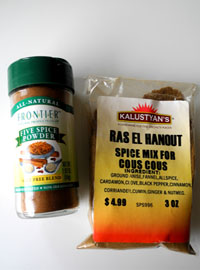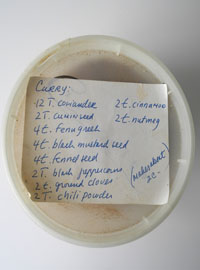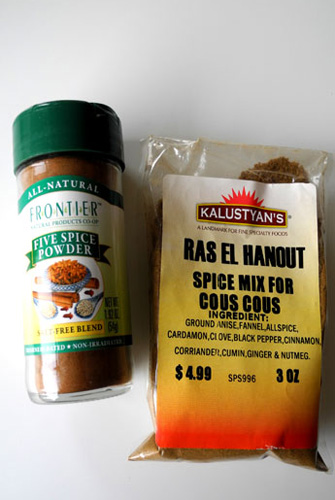Spice Mixes 101
A few weeks ago, when this just-ended winter was still stuck at hopelessly frigid, cooking a five-hour roast felt like a reasonable thing to do for a dinner party. The Wall Street Journal had just published an appealing recipe by Chef Daniel Boulud, one he first published about thirty years ago as a new chef, and then again in his first cookbook, published in 1993.
Braised Leg of Lamb Cleopatra is a recipe that Boulud credits to an Egyptian chef he met early in his career. Eleven spices are combined into a rub used to season the lamb, which is browned and then slow roasted with aromatic vegetables that reduce into a flavorful sauce. The finished lamb, vegetables, and sauce are served with couscous with raisins and almonds.
The dish was a triumph and my guests loved it, although the next time I make it -- maybe next winter because both its long cooking and complex flavors really demand a cold winter's day -- I will use a lamb shoulder instead of a leg. Everything I knew about how to best cook different cuts of meat screamed in my head to never slow-braise a leg as it will end up dry and tough. Slow braising is for a shoulder or chuck or butt, not a tender leg. I respect Chef Boulud but in this case I was right as the flavor was brilliant but the texture was not. Plus a shoulder cut costs a fraction of a bone-in leg of lamb.
But let's go back to those eleven spices, which more than anything, gave the dish its complex and satisfying flavor. If you've ever been to Egypt and either walked Cairo's spice markets, or dined in a small neighborhood restaurant, or had the privilege of eating in an Egyptian home, you will recognize this perfumed mix as from no where else on earth:
- Cumin
- Cinnamon
- Allspice
- Coriander
- Nutmeg
- Fennel seeds
- Cardamom
- Ginger
- Star anise
- Cloves
- Cayenne
Sweet, savory, musky, hot, fragrant, and complex: a mix of spices like this becomes a chef's signature. But even more, some spice mixes define entire cuisines. Depending upon how you cook and where you've traveled and perhaps the ethnicity of your family and the foods you ate as a child, just the name of a spice mix can provoke a profound sense memory: think jerk spice or ras el hanout or garam masala or pumpkin pie spice. How can you help but have a craving?
Reading history tells us how much of the world was explored, exploited, traveled, and conquered simply to score and transport the spices that civilized centers demanded. Today most spice mixes can either be bought already made or else we can purchase the ingredients and mix them ourselves, although some international mixes include hard-to-find spices, as korarima used in eastern Africa's Berbere mix.
Buying Versus Making Your Own Spice Mixes
We home cooks are constantly juggling time, costs, and flavor, and every day we make choices about what to buy versus what to make. As examples -- pizza dough, puff pastry, chicken stock, ravioli, granola, peach jam. I could go on.
In a perfect world we would also have the time to shop for fresh herbs and spices, buy them in whole form, and toast and grind them as needed. But this isn't always a practical option. Moreover, some spice producers do a very good job of sourcing and mixing, which is especially appreciated when it's a mix we use infrequently and thus only need modest quantities, which for me translates into anything smaller than a 2 oz. spice jar.
But as I learned when I gathered the eleven spices for Cleopatra's braised lamb, the best flavor comes from just-ground, recently purchased spices that we mix ourselves. That means that if you cure your own charcuterie, you should try to also make your own quatre épices. If curry is a frequent dish in your kitchen, make your own curry mix; I also predict that if you keep a jar of your own curry powder on hand that you'll use it often, as in butternut squash soup or on roasted vegetables.
Mixing your own also means you'll add what you want and avoid what you don't. For instance, a commercially mixed herbes de Provence made for the US market usually includes lavender (which to my palate tastes like soap), but in France it's excluded. So you can mix yours exactly as you like. Plus homemade instead of store-bought means you won't get the manufacturer's addition of such things as MSG or sugar or anti-caking agents like silicon dioxide.
To mix your own spices, invest in a coffee grinder that you'll keep dedicated just to spice grinding. A Krups grinder costs about $20; just don't use it also for coffee beans or else your spices will taste like coffee and visa versa. Also buy a small paint or pastry brush so to brush out every speck of a spice once you've turned it from seed to powder. To store your spice mixes, use glass jars with tight-fitting covers; recycled jars from mustard, baby food, capers, or jams are perfect, plus their small size will remind you to not make spice mixes in big quantities.
Sourcing Spices
The fresher the spices the bigger the flavor. So when buying spice mixes already made, it's important to do so at a busy retailer that has lots of turnover. This is a bit of a challenge because there's no freshness date on spice jars and you could end up being the first customer in weeks to buy Sichuan peppercorns. Worse, once we get them home we may use them once and then they get lost among our other spices. One tip is to write the purchase date on the label so that the next time you need a tablespoon of adobo, you'll know whether you bought it last month or last year.
Better is to buy spices from a spice merchant. Online this includes Penzey's, which also has a national network of retail stores; check their website for locations.
In New York City, Kalustyan's is a favorite and they also sell from their decidedly non-slick website. But if you can visit the store itself, you will be tempted by just about any spice sourced anywhere in the world, usually sold in multiple sizes.
Two other very good spice shops in New York, albeit less known than Kalustyan's, are Spice Corner at 135 Lexington Avenue at 29th Street, and Dual Specialty at 91 First Avenue at 6th Street.
In the Midwest, The Spice House is another online resource, plus they have stores in Chicago, Evanston, Illinois, Milwaukee, and other locations.
Popular Spice Mixes From Around The World
Spice mixes are more art than science, and for any mixture that I list here there will be many other versions, maybe as many as there are chefs and cooks that create and use them. So please consider this list as simply a guide and initial inspiration for how you can add more complex flavor to your cooking.
- Curry: A south Asian spice mix; a similar mixture is used in northern India and is called garam masala. Most curries include coriander, turmeric, cumin, fenugreek, chili peppers, plus also ginger, garlic, fennel seed, caraway, cinnamon, clove, mustard seed, cardamom.
- Garam Masala: From the words meaning "hot" (garam) and "mixture of spices" (masala), this mixture typically includes turmeric, black and white peppercorns, cloves, cinnamon, black and white cumin seeds, and black, brown, and green cardamom pods.
- Tandoori Masala: Used in clay oven cooking in northern India, Pakistan, and Afghanistan. There is some variance among tandoori masalas but usually they include garam masala, garlic, ginger, onion, and cayenne pepper.
- Chaat Masala: A curry mixture made tangy with the addition of dried mango (called amchoor).
- Chinese Five Spice Powder: A popular mixture used on fatty meats like duck or pork, this spice combination is used not only in Chinese cooking but also in other Asian cuisines, including Vietnamese. This mixture usually includes star anise, cloves, cinnamon, black or Sichuan peppercorns, and fennel seeds. It may also include turmeric, nutmeg, licorice, or allspice.
- Gomasio: A Japanese mixture of toasted sesame seeds and salt. Used as a popular condiment.
- Togarashi: Also Japanese, togarashi is the name given to chili peppers as well as a mixture of chili pepper, citrus peel, black and white sesame seeds, sancho, ginger, and nori seaweed. The mixture is also called shichimi.
- Za'atar: Also spelled zaatar, za'tar, zatr, and several other variants, za'atar is both an herb related to oregano, and also a spice mixture of thyme, savory, sesame seeds, sumac, and salt. It sometimes also may include cumin or fennel seeds. Za'atar is used in Arab and Middle Eastern cooking as a simple seasoning for fresh bread or sprinkled on popcorn, yogurt, chickpeas, toasted pita drizzled with olive oil, hummus, eggs, or goat cheese.
- Harissa: A spicy paste made primarily from smoked red peppers but may also include garlic, coriander, and other spices. Used in North African cuisines.
- Baharat: Used in Arab, Turkish and Iranian cuisines especially with lamb, fish, beef, chicken, and as a condiment. Usually includes allspice, peppercorns, cardamom, cassia bark, cloves, coriander, cumin, nutmeg, dried chili peppers or paprika.
- Berbere: A spice mixture popular in Ethiopian, Somalian, and other African cuisines, this lively combination usually includes chili peppers, garlic, ginger, dried basil, nigella, fenugreek, korarima (from the ginger family), and other indigenous spices.
- Ras el Hanout: A North African spice mixture with a name that means "head of the shop," suggesting that this mixture is made from the best that the spice merchant has to offer. Usually includes some combination of cardamom, clove, cinnamon, chili peppers, cumin, peppercorns, paprika, fenugreek, and turmeric. There are regional variations with other additions including anise, fennel, or coriander. Used often in Moroccan cooking including couscous and tagines.
- Dukkah: Also known as Duqqa, this is an Egyptian mix of herbs, nuts (usually hazelnuts), and spices that is used as a dip and condiment sprinkled on dishes. The mixture usually includes sesame seeds, coriander, cumin, and salt and pepper.
- Vadouvan: A derivative of a curry blend with a European influence that is thought to have originated with the French colonial presence in India. The mixture is usually a masala with added spices such as shallots and garlic.
- Herbes de Provence: A southern French mixture of dried savory, marjoram, rosemary, thyme, and oregano. Versions made for the US market includes dried lavender. Used when cooking fish and meats, both in grilling and in stews.
- Fine Herbes: A four-herb classic mixture that is core to French cuisine -- parsley, chives, tarragon, chervil. Sometimes other mild herbs such as marjoram or lemon balm may be added.
- Quatre Épices: A mixture used in French and Middle Eastern cooking, including as a key flavoring when curing meats such as duck legs for confit de canard. Usually includes ground pepper, cloves, nutmeg, and ginger. Also used in soups and ragouts.
- Adobo: A combination of seasonings popular in Latin American and Mexican cooking. Usually includes garlic, oregano, and pepper.
- Jerk Spice: A high heat mixture of red and black pepper, allspice, cinnamon, and thyme. Best known as a seasoning for chicken and fish.
- Taco Seasoning: Far superior to any mix you can buy already made. Combine chili powder, cumin, garlic powder, oregano, salt, cayenne, and black pepper.
- Chili Powder: Sometimes mistakenly used in place of ground chilies, this mixture includes other spices in addition to the ground chilies including cumin, oregano, garlic powder, and salt.
- Apple Pie Spice: Used in classic American apple pies but also as a flavoring for other desserts, such as rice pudding and apple dumplings. Includes cinnamon, nutmeg and allspice.
- Pumpkin Pie Spice: As with the version for apple pie, this mixture flavors an American favorite, in this case pumpkin pie. Usually includes cinnamon, nutmeg, cloves, and ginger.
- American Dry Rub: Used in barbecue and said to have originated in Kansas City. Includes brown sugar, paprika, garlic powder, and other spices.
- Pickling Spices: Used in pickling vegetables and fruits, this mixture typically includes bay leaves, mustard seeds, and black peppercorns.
- Bay Seasoning: Originally created by McCormick & Company to give versatility to Maryland's Chesapeake Bay crabs, this mixture is now popularly used to season other seafood as well as on corn on the cob, in Bloody Marys, and on popcorn and chips. Bay seasoning is a mixture of mustard, paprika, celery salt, bay leaf, black pepper, crushed red pepper flakes, mace, cloves, allspice, nutmeg, cardamom, and ginger.
Making Your Own
Here are some classic spice mixtures you can make yourself.
First, by chef and writer David Tanis, his version of Five Spice Powder that he used in a glaze for roasted duck:
1 teaspoon black peppercorns
1 teaspoon Sichuan peppercorns
1 teaspoon fennel seed
1 teaspoon cloves
6 star anise
A 2-inch piece of cinnamon stick (crushed)
12 allspice berries
Combine in an electric spice mill and grind to a fine powder. Yields about 3 tablespoons. Store in a glass jar.
Next is my curry mixture. It's actually not mine because it was sent to me years ago by a reader who in turn had received it from Chef Sumanth Das who was born in Mumbai. But it's the only curry mixture I've ever used:
12 tablespoons coriander
2 tablespoons cumin seed
4 teaspoons fenugreek
4 teaspoons black mustard seed
4 teaspoons fennel seed
2 tablespoons black peppercorns
2 teaspoons ground cloves
2 tablespoons chili powder
2 teaspoons cinnamon
2 teaspoons nutmeg
1/2 cup turmeric
Grind each spice to a fine powder and combine everything together. Yields about 2 cups. Store in a glass jar.
Third, here is how to make your own za'atar.
4 tablespoons dried thyme
2 teaspoons sumac
1 tablespoon toasted sesame seeds
1/2 teaspoon sea salt
Optional: 2 tablespoons dried oregano, 2 tablespoons dried marjoram
Add the sesame seeds to an electric spice mill or using a mortar and pestle, grind them into a coarse paste. Add to the other ingredients and combine well. Yields about 5 tablespoons. Store in a glass jar in a cool, dark place where it can keep for about 3 months.
Make your own taco seasoning and you'll never buy it pre-mixed again.
1 tablespoon chili powder
1/4 teaspoon garlic powder
1/4 teaspoon onion powder
1/4 teaspoon crushed red pepper flakes
1/4 teaspoon dried oregano
1/2 teaspoon paprika
1 1/2 teaspoons ground cumin
1 teaspoon sea salt
1 teaspoon black pepper
Makes about 1 ounce or 3 tablespoons
It's a small thing, to make your own spice mixtures. But it's surprising how it can increase our flavor confidence as well as control over how we cook and what we eat.


